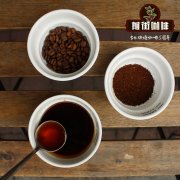Flavor and taste characteristics of coffee beans how to describe how to drink the flavor of fine coffee

Professional coffee knowledge exchange more coffee bean information please follow the coffee workshop (Wechat official account cafe_style)
What is the flavor of coffee?
The flavor review of each kind of coffee combines people's intuitive description of the taste of coffee, including its thickness (consistency), acidity, aroma, bitterness, sweetness and aftertaste. The so-called balanced flavor of coffee means that there is no overly prominent flavor in the coffee. Although there are many excellent quality coffees with a balanced flavor, there are exceptions: some coffees are popular because of their special flavors.
The description of coffee flavor
Generally speaking, the industry will evaluate coffee on the basis of its complexity (for example, multi-layered taste) and thickness (for example, full-bodied). However, some people also use the way of association: to comment on the flavor of other foods, just as some coffee has the flavor of red wine, or when some coffee tastes like berries, the industry usually uses these physical objects to describe its flavor.
If this cup of coffee has a fruity flavor, it usually means that it has a natural sweet taste, and some high-quality coffee has the same taste. There are basically three types of fruits: hard-shelled fruits (stone fruit) (peaches, apricots and nectarines), oranges (oranges, lemons, grapefruit) and berries (raspberries, strawberries, blackberries, blackcurrants, cherries). Generally speaking, African beans are mostly fruit-flavored, but they are found to be a secondary flavor in South African beans. Here are some common flavors in some areas:
Kenya: berries Ethiopia Yega Sheffield region: citrus (lemon) Brazil: fruit (cherry) Costa rica: tropical fruit Tanzania: tropical fruit (kiwi), berries (BlackBerry)
Guatemala: citrus (oranges, green apples) Colombia: berries (blackberries, blackcurrants) and shelled fruits (peaches, apricots)
The environmental conditions of the producing areas vary from year to year, which means that the taste of each region will change from year to year. Even coffee beans produced in the same country may end up brewing coffee with different tastes. In addition, fruit flavor rarely occurs in deep-cultivated beans (espresso roast) because the original organic matter of coffee is destroyed under the condition of deep cultivation. It is worth noting that although there is the word "concentrated" in the original text, it does not mean that only deep-cultivated beans can be concentrated.
How to taste the flavor of coffee
The human body mainly receives the water-soluble flavor and fragrance compounds in coffee through the sense of smell (nose mucosa) and taste buds (nerves on the surface of the tongue).
The cup tester (coffee supervisor) usually comments on the taste of coffee in terms of acidity, aroma, thickness or aftertaste. Usually the flavor we see on the packaging of coffee beans comes from this.
Concentrated is not a kind of coffee beans, but refers to the liquid that is brewed under the coffee machine without adding any ingredients (so any coffee beans can be brewed in the coffee machine). But if you hear the word "peel" added after the concentrate, it means it's deep-baked coffee.
Compared with other kinds of coffee drinks, the concentrated taste is the strongest. This is because it has the highest coffee concentration. The finer the coffee powder used in the coffee machine, the higher the concentration of coffee that can be extracted. (just like stones and fine sand in bottled water)
Important Notice :
前街咖啡 FrontStreet Coffee has moved to new addredd:
FrontStreet Coffee Address: 315,Donghua East Road,GuangZhou
Tel:020 38364473
- Prev

About the flavor characteristics of coffee how to describe the flavor of coffee
Professional coffee knowledge exchange more coffee bean information Please follow the coffee workshop (Wechat official account cafe_style) eating refined chocolate is not only a simple indulgence, but a complex sensory experience, full of a variety of flavors, aromas and textures. From delicate floral aromas to creamy tastes, the best cocoa and chocolate can create unique flavors. We are always buying coffee.
- Next

What is blended coffee? how do you mix coffee beans? what is blended coffee beans?
Professional coffee knowledge exchange more coffee bean information please follow the coffee workshop (Wechat official account cafe_style) in this era, people have an extraordinary pursuit of nature and purity. When the all-natural, 100% unadded words become the standard of the times, pure single coffee has become the magic weapon of cafes that sell boutique coffee. These are marked with single production.
Related
- Beginners will see the "Coffee pull flower" guide!
- What is the difference between ice blog purified milk and ordinary milk coffee?
- Why is the Philippines the largest producer of crops in Liberia?
- For coffee extraction, should the fine powder be retained?
- How does extracted espresso fill pressed powder? How much strength does it take to press the powder?
- How to make jasmine cold extract coffee? Is the jasmine + latte good?
- Will this little toy really make the coffee taste better? How does Lily Drip affect coffee extraction?
- Will the action of slapping the filter cup also affect coffee extraction?
- What's the difference between powder-to-water ratio and powder-to-liquid ratio?
- What is the Ethiopian local species? What does it have to do with Heirloom native species?

